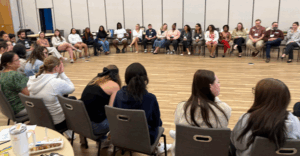Healing in Community: Talking Circle at NCCASA’s Inter-Tribal Gathering
November 6, 2025
At NCCASA’s Intertribal Gathering, participants and leaders across North Carolina came together to engage in a talking circle, which is a deeply intentional healing space where survivors and community members share their experiences with survivorship, both personal and within their communities. This space was not only a moment of storytelling, but an act of collective care, resilience, and truth-telling.
What Is a Native American Talking Circle? A Sacred Space for Shared Voice
A Native American talking circle is a traditional practice used by many Indigenous communities to promote healing, connection, and shared understanding. It is not a debate or a discussion—it is a sacred space for listening, truth-telling, and being in community.
In a talking circle, participants sit together in a circle to emphasize unity and equality—no one is placed above or below another. A symbolic item, often referred to as a talking piece (such as a feather, stone, or handmade item), is passed around. Whoever holds the talking piece has the opportunity to speak, while others listen without interrupting, judging, or planning a response. At the Inter-Tribal Gathering, a talking stick was used to give each participant the space and opportunity to share. Participants were then welcomed to share as much or as little as they wanted, ensuring that each and every voice was heard and included.
Values Guiding the Circle and Conversation
Talking circles are guided by core values deeply rooted in Indigenous teachings. The core values below guided the talking circle discussion, and the quotes are by current NCCASA interns who attended the talking circle and who are Public Health Students at Campbell University. A special thank you to them for sharing their experiences.
-
- Respect for each person’s story, silence, and way of being.
- “There was a talking stick that was passed around to indicate whose turn it was to speak. You didn’t have to speak if you didn’t want to, you could pass around the stick, but each person had an opportunity to speak.”
- “Everyone was quiet while you were talking, there was no interrupting…”
-
- Listening to understand, not to respond.
- “It felt like people were hearing me.”
- “Everyone was quiet while you were talking, there was no interrupting…”
-
- Confidentiality and trust that what is shared in the circle remains in the circle.
- “Even if people didn’t have their own stories to share, they would often say things like “I hear you” and “thank you for sharing” to affirm each other’s experiences.”
- “Everything felt like it moved so naturally and I never felt uncomfortable sharing.”
-
- Healing and building community through recognizing that harm and healing are both collective experiences.
- “The talking center was cathartic. We each had our own stories about how sexual assault affects us personally, and it was a great opportunity to be reminded that we are not alone. It was very special to have this space to do so and it was empowering.”
- “For those of us who shared, it felt like we were breaking down barriers.”
- “Being able to share together was a beautiful moment, especially because there were multiple generations of people in the room with shared experiences.”
Talking Circles in the Context of Survivorship
In the context of survivorship, talking circles are powerful tools for healing trauma, addressing societal stigma, and engaging communities in important conversations about preventing and addressing sexual violence. especially when facilitated by Indigenous leaders and carried out with cultural respect. They offer a space where survivors and community members can speak openly about pain, loss, resistance, and resilience while being seen and held by their community.
At NCCASA’s Intertribal Gathering, this tradition was honored through a POC- and Native-led talking circle, where elders and community leaders helped shape the space centering the value that “All Are Welcome.” The circle was supported by two licensed therapists, and a sensory room was made available to ensure participants’ emotional and physical safety.
NCCASA’s Prevention Education Program Manager, Omar Godwin, was intentional in implementing a safe and inclusive experience for all participants. Licensed clinical therapist, and Waccamaw Siouan Tribal member, Alicia Freeman, graciously offered to provide care for folks during the gathering and talking circle. Alicia also piloted a “sensory space” for participants, ensuring that there were various pathways for participants to access support and healing. Polly Cox, a Department of Public Health employee and member of the Lumbee Tribe, co-facilitated the space alongside Alicia, ensuring that there were committed and trained facilitators on deck. This process also showcased the power of cross-organizational collaboration, especially when the values of healing, cultural heritage, and inclusivity are at the center.
As we look towards the future, NCCASA is committed to continue listening to, including, and following in the leadership of Indigenous communities in the movement to end sexual violence. We are grateful to be in community with so many thought-leaders, advocates, and healers alike.


